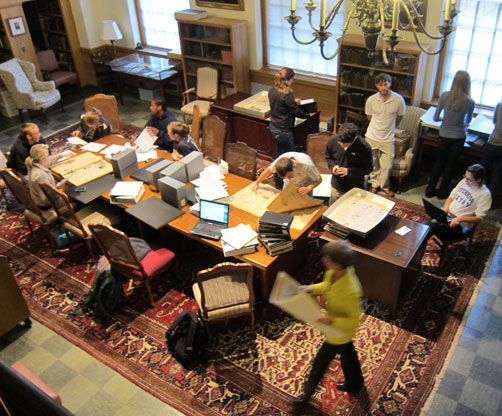This article is more than 5 years old.

Students from History Through the Lens of Documentary Film researching in the Special Collections Reading Room
In recent years, an active program of instruction and outreach has made Special Collections and Archives a destination for more and more Wake Forest students. In the 2011-12 academic year, 34 different classes – over 400 students – visited Special Collections.
Faculty may schedule class visits and can work with librarians to create assignments that use primary source material such as books, manuscripts, photographs and maps. The FYS History Through the Lens of Documentary Film typifies the opportunities available in Special Collections. Cara Pilson taught this FYS for the third time in the spring of 2012. Each of her FYS classes has included a final project based on materials from the WFU Archives.
Dr. Pilson wanted her students to create brief documentary films about the experiences of Wake Forest students from earlier eras. The students in fall 2010 investigated issues facing students in the 1960s. They focused on the ways in which the Wake Forest community reacted to events in the wider world.
As a first step, Dr. Pilson and librarians discussed her course goals and expectations for the project. The librarians then recommended appropriate resources from the archives. Dr. Pilson wanted her students to experience the process as well as the products of archival research. Therefore, the students were presented with a selection of resources, which they then had to evaluate to select the most appropriate specific items for their projects.
This model has worked well for all three History Through the Lens of Documentary Film classes. The spring 2012 class had a broader range of topics in a timespan that ranged from the 1940s through the 1980s, which meant that they used a greater variety of archival resources. As in previous semesters, the class visited Special Collections early in the semester to receive a basic introduction to the department’s holdings, methods of archival research, and appropriate handling of archival materials. They then returned to do research throughout the semester, both independently and with Dr. Pilson in attendance.
For historical research at any level, there is no substitute for direct interaction with primary sources. The students were amazed, amused and sometimes appalled by what they found in the archives. Issues of the Old Gold and Black from the early 1940s featured editorials by a student named Edwin G. Wilson, describing the privations of a wartime campus. The Wake Forest Women’s Government Association minutes from the 1950s detailed the many infractions for which female students could face disciplinary action (including “appearing in parlor doorway wearing shorts” and “shouting to boys out of window”). The correspondence files of President Harold Tribble include strongly worded letters (both pro and con) reacting to the decision to integrate Wake Forest. This unmediated contact with voices from the past gave students the opportunity to stretch their critical and interpretive skills. The students also faced the challenge of finding materials that could provide visual impact for their films. With some guidance, undergraduate students from this and other classes can use archival resources in fascinating and creative ways.
Putting resources into the hands of Wake Forest students is a primary goal in Special Collections and Archives. If you want to learn more about how these materials might fit into your course, please contact Special Collections Librarian Megan Mulder at x5091.
